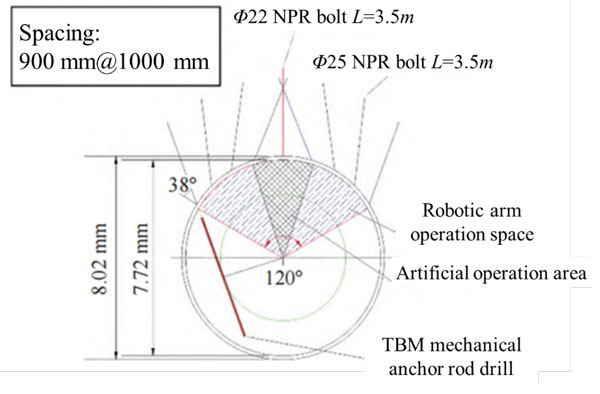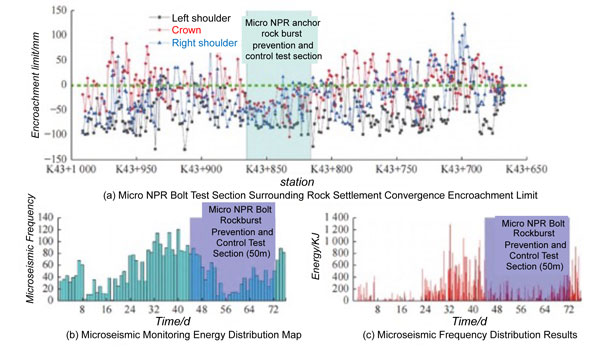Qinling Water Diversion Tunnel
发布时间:2024年12月24日
浏览数:116
1. Engineering Significance
The Hanjiang-to-Weihe River Water Diversion Project spans the Yangtze and Yellow River basins, diverting water from the Hanjiang River, the largest tributary of the Yangtze River, to the Weihe River, the largest tributary of the Yellow River. This effectively replenishes the water resources of the Yellow River basin, significantly alleviating the long-standing water scarcity in the Guanzhong Plain and northern Shaanxi. It greatly improves the uneven spatial distribution of water resources in China, achieving optimized allocation of these resources[1].
Starting from the southern regions, there are the Central Yunnan Water Diversion Project, the Yangtze-to-Hanjiang Water Diversion Project, and the Hanjiang-to-Weihe River Water Diversion Project. These projects collectively form integral components of China's South-to-North Water Diversion initiative[2]. Among them, the Hanjiang-to-Weihe River Water Diversion Project is an essential and integral part of this massive undertaking. Once completed, the project is expected to divert an average of 1.5 billion cubic meters of water annually. This will meet the production and domestic water demands of four major cities—Xi'an, Xianyang, Weinan, and Yangling—as well as 11 counties, 5 new urban districts, and one industrial park along the Weihe River, benefiting a population of approximately 14.11 million. The project will also curtail the over-extraction of groundwater and ecological water in the Guanzhong region, enhance the carrying capacity of water resources, and restore the ecological health of the Weihe River[3].
2. Project Overview
The Qinling Water Diversion Tunnel, the first project in human history to traverse the Qinling Mountains from the base, spans a total length of 98.3 kilometers with a maximum burial depth of 2,012 meters. Designed with a flow capacity of 70 cubic meters per second, this project is not only immense in scale but also technically demanding, serving as the critical control node of the Han-to-Wei Water Diversion Project. The geological conditions of the Qinling Mountains are highly complex, with the tunnel crossing three major regional fault zones, four secondary fault zones, and 33 minor fault zones, encompassing over 20 types of rock formations. The quartz content of the surrounding rock reaches 96%, with compressive strength exceeding 300 MPa, comparable to steel plates[3]. Construction faced challenges such as sudden water inflows, frequent and intense rock bursts, and fault collapses, making its difficulty unparalleled both domestically and internationally.
The northern section of the Qinling Tunnel is situated in the Western Qinling Mountain region, characterized by rugged terrain and extremely complex geological conditions. High in-situ stress conditions dominate the section, with a burial depth exceeding 500 meters along 61.4 kilometers of the tunnel. High-risk rock burst zones extend over 27 kilometers. According to field monitoring, from January 6, 2020, to January 18, 2022, a total of 8,012 rock bursts were recorded, exhibiting diverse patterns, time-dependent effects, significant damage potential, and high prediction difficulty[5]. These issues pose substantial challenges to construction safety and progress.
Due to the deep burial depth and high in-situ stress of the Qinling Tunnel, traditional rock control methods, typically designed for shallow and mid-depth excavation, are inadequate for rock burst management in such deep underground projects. To address this, academician Manchao He and his team proposed an innovative excavation compensation theory[4]. This theory posits that prior to excavation, the surrounding rock remains in a stable state, with stress levels below the Mohr-Coulomb strength envelope. However, excavation disrupts the stress equilibrium, causing a reduction in radial stress to zero and an increase in tangential stress. This leads to unbalanced stress unloading in one direction, triggering the expansion of the Mohr stress circle, deformation, instability of the surrounding rock, and ultimately rock bursts[5]. Figure 2 shows the excavation stress compensation model.
Conventional low-stress compensation techniques or standard support systems fail to provide sufficient counterforce to balance the unbalanced forces induced by excavation, resulting in support failure. To effectively manage deformation and instability of the surrounding rock, a high-stress compensation approach was devised. The innovative use of micro negative Poisson’s ratio (NPR) bolts as a new support material, coupled with a newly designed support system, has demonstrated significant potential in controlling geological hazards such as large-scale rock deformation.
The second-generation micro NPR bolts, made from high-strength and high-toughness alloy steel, exhibit excellent NPR effects. When subjected to axial tension or compression, these bolts uniformly deform along their entire length without necking, providing enhanced resilience and energy absorption capacity. Additionally, they possess superior anti-explosion and anti-impact properties, making them particularly suited for managing large rock deformations[5]. Figure 3 shows the micro NPR anchor support design scheme.
Based on the excavation compensation theory and second-generation micro NPR bolts, a three-dimensional NPR high-stress compensation support system was developed. This system integrates radial micro NPR bolts, axial flexible nets, and circumferential W-shaped steel strips, effectively mitigating rock burst hazards. Field monitoring data from the trial section (K43+865 to K43+815) revealed significant reductions in microseismic energy and frequency, improved integrity of the surrounding rock, decreased depth of bursting pits, and reduced deformation and stress on steel arches, underscoring the efficacy of the support system (Figure 4).
The implementation of the NPR-based three-dimensional high-stress compensation support system has effectively controlled the deformation and failure of the surrounding rock, significantly enhancing the tunnel's stability and safety. In high-stress and fractured rock sections, this support system reduced deformation, optimized the stress state of support structures, and prevented failures caused by excessive deformation of the surrounding rock.
References
[1]https://www.sohu.com/a/223556864_659822
[2]https://www.toutiao.com/article/7298909976720949775/
[3]https://www.ourchinastory.com/cn/10036/
[4]Manchao He, Shulin Ren, Zhigang Tao. Methods for Catastrophic Disaster Prevention and Control of Deep-Buried Tunnels [J]. Journal of Engineering Geology, 2022, 30 (06): 1777-1797. DOI: 10.13544/j.cnki.jeg.2022-0703.
[5]Zhigang Tao, Junzheng Zhao, Jie Hu, et al. 3D NPR Support Technology for Rockbursts in the Qinling Water Diversion Tunnel of the South-to-North Water Diversion Project [J]. South-to-North Water Transfer and Water Conservancy Science & Technology (Bilingual), 2023, 21 (06): 1165-1173. DOI: 10.13476/j.cnki.nsbdqk.2023.0115.
The Hanjiang-to-Weihe River Water Diversion Project spans the Yangtze and Yellow River basins, diverting water from the Hanjiang River, the largest tributary of the Yangtze River, to the Weihe River, the largest tributary of the Yellow River. This effectively replenishes the water resources of the Yellow River basin, significantly alleviating the long-standing water scarcity in the Guanzhong Plain and northern Shaanxi. It greatly improves the uneven spatial distribution of water resources in China, achieving optimized allocation of these resources[1].
Starting from the southern regions, there are the Central Yunnan Water Diversion Project, the Yangtze-to-Hanjiang Water Diversion Project, and the Hanjiang-to-Weihe River Water Diversion Project. These projects collectively form integral components of China's South-to-North Water Diversion initiative[2]. Among them, the Hanjiang-to-Weihe River Water Diversion Project is an essential and integral part of this massive undertaking. Once completed, the project is expected to divert an average of 1.5 billion cubic meters of water annually. This will meet the production and domestic water demands of four major cities—Xi'an, Xianyang, Weinan, and Yangling—as well as 11 counties, 5 new urban districts, and one industrial park along the Weihe River, benefiting a population of approximately 14.11 million. The project will also curtail the over-extraction of groundwater and ecological water in the Guanzhong region, enhance the carrying capacity of water resources, and restore the ecological health of the Weihe River[3].
2. Project Overview
The Qinling Water Diversion Tunnel, the first project in human history to traverse the Qinling Mountains from the base, spans a total length of 98.3 kilometers with a maximum burial depth of 2,012 meters. Designed with a flow capacity of 70 cubic meters per second, this project is not only immense in scale but also technically demanding, serving as the critical control node of the Han-to-Wei Water Diversion Project. The geological conditions of the Qinling Mountains are highly complex, with the tunnel crossing three major regional fault zones, four secondary fault zones, and 33 minor fault zones, encompassing over 20 types of rock formations. The quartz content of the surrounding rock reaches 96%, with compressive strength exceeding 300 MPa, comparable to steel plates[3]. Construction faced challenges such as sudden water inflows, frequent and intense rock bursts, and fault collapses, making its difficulty unparalleled both domestically and internationally.
Figure 1. Schematic of the "South-to-North Water Diversion" Project (Source: China Railway Construction WeChat Official Account)
3. Key Technical Challenges and SolutionsThe northern section of the Qinling Tunnel is situated in the Western Qinling Mountain region, characterized by rugged terrain and extremely complex geological conditions. High in-situ stress conditions dominate the section, with a burial depth exceeding 500 meters along 61.4 kilometers of the tunnel. High-risk rock burst zones extend over 27 kilometers. According to field monitoring, from January 6, 2020, to January 18, 2022, a total of 8,012 rock bursts were recorded, exhibiting diverse patterns, time-dependent effects, significant damage potential, and high prediction difficulty[5]. These issues pose substantial challenges to construction safety and progress.
Due to the deep burial depth and high in-situ stress of the Qinling Tunnel, traditional rock control methods, typically designed for shallow and mid-depth excavation, are inadequate for rock burst management in such deep underground projects. To address this, academician Manchao He and his team proposed an innovative excavation compensation theory[4]. This theory posits that prior to excavation, the surrounding rock remains in a stable state, with stress levels below the Mohr-Coulomb strength envelope. However, excavation disrupts the stress equilibrium, causing a reduction in radial stress to zero and an increase in tangential stress. This leads to unbalanced stress unloading in one direction, triggering the expansion of the Mohr stress circle, deformation, instability of the surrounding rock, and ultimately rock bursts[5]. Figure 2 shows the excavation stress compensation model.
Figure 2. Excavation Stress Compensation Model (Image source: [4])
Conventional low-stress compensation techniques or standard support systems fail to provide sufficient counterforce to balance the unbalanced forces induced by excavation, resulting in support failure. To effectively manage deformation and instability of the surrounding rock, a high-stress compensation approach was devised. The innovative use of micro negative Poisson’s ratio (NPR) bolts as a new support material, coupled with a newly designed support system, has demonstrated significant potential in controlling geological hazards such as large-scale rock deformation.
The second-generation micro NPR bolts, made from high-strength and high-toughness alloy steel, exhibit excellent NPR effects. When subjected to axial tension or compression, these bolts uniformly deform along their entire length without necking, providing enhanced resilience and energy absorption capacity. Additionally, they possess superior anti-explosion and anti-impact properties, making them particularly suited for managing large rock deformations[5]. Figure 3 shows the micro NPR anchor support design scheme.
Figure 3. Micro NPR Bolt Support Design Scheme (Image source: [4])
Based on the excavation compensation theory and second-generation micro NPR bolts, a three-dimensional NPR high-stress compensation support system was developed. This system integrates radial micro NPR bolts, axial flexible nets, and circumferential W-shaped steel strips, effectively mitigating rock burst hazards. Field monitoring data from the trial section (K43+865 to K43+815) revealed significant reductions in microseismic energy and frequency, improved integrity of the surrounding rock, decreased depth of bursting pits, and reduced deformation and stress on steel arches, underscoring the efficacy of the support system (Figure 4).
Figure 4. On-site Monitoring Data (Image source: [4])
4. ConclusionThe implementation of the NPR-based three-dimensional high-stress compensation support system has effectively controlled the deformation and failure of the surrounding rock, significantly enhancing the tunnel's stability and safety. In high-stress and fractured rock sections, this support system reduced deformation, optimized the stress state of support structures, and prevented failures caused by excessive deformation of the surrounding rock.
References
[1]https://www.sohu.com/a/223556864_659822
[2]https://www.toutiao.com/article/7298909976720949775/
[3]https://www.ourchinastory.com/cn/10036/
[4]Manchao He, Shulin Ren, Zhigang Tao. Methods for Catastrophic Disaster Prevention and Control of Deep-Buried Tunnels [J]. Journal of Engineering Geology, 2022, 30 (06): 1777-1797. DOI: 10.13544/j.cnki.jeg.2022-0703.
[5]Zhigang Tao, Junzheng Zhao, Jie Hu, et al. 3D NPR Support Technology for Rockbursts in the Qinling Water Diversion Tunnel of the South-to-North Water Diversion Project [J]. South-to-North Water Transfer and Water Conservancy Science & Technology (Bilingual), 2023, 21 (06): 1165-1173. DOI: 10.13476/j.cnki.nsbdqk.2023.0115.














 中国岩石力学与工程学会微信订阅号
中国岩石力学与工程学会微信订阅号
 科普岩石力学与工程
科普岩石力学与工程